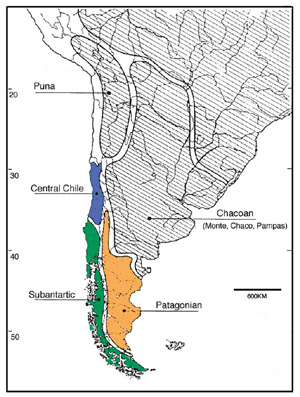.. |
STUDY
AREA |
| |
 |
|
A
distinct and widely recognized biogeographical region is targeted
as the focal region for analysis. Southern South America is
distinct for its biota (see Darlington 1965, Crisci et al.
1991, Linder and Crisp 1995, Morrone et al. 1996, Humphries
and Parenti 1999, Katinas et al. 1999, Posadas et al. 1999).
Many papers have been published recognizing high levels of
endemicity insouthern South America. The study area includes
Chile south of Coquimbo and adjacent areas of Argentina roughly
southwest of a diagonal line between Mendoza and the Península
Valdés (including the provinces of Neuquen, Río
Negro, Chubut, Santa Cruz, and Tierra del Fuego). The study
area is comprised of many different types of habitats, including
Valdivian temperate rain forests, high elevation grasslands
in the Andes, Patagonian steppe and grasslands, Mediterranean
climate rain forests in Central Chile, and subantarctic Nothofagus
forests. From west to east there is a rapid change in elevation
and habitat from |
| coastal
forests and a coastal mountain range to a forested central
valley, then the high Andes and drier steppe and grasslands
beyond in Argentina. |
|
| |
|
| |
Crisci
et al. (1991) examined the historical biogeography of southern South
America and concluded that the area is more biologically similar to
other southern hemispheric landmasses (Australia, New Zealand, New
Guinea, etc.) than to northern South America. The relationships of
numerous groups of organisms support this southern hemispheric biogeographical
pattern including scarab beetles (Howden 1981, Smith 2002), staphylinid
beetles (Newton 1985, Thayer 1985), silphid beetles (Peck and Anderson
1985), carabid beetles (Darlington 1979, Erwin 1979), chironomid flies
(Brundin 1981), spiders (Goloboff and Platnick 1987, Platnick 1991),
waratahs plants (Weston and Crisp 1987), and Nothofagus trees
(Linder and Crisp 1995). My preliminary estimates for scarabs support
these findings because about 60% of scarab species from southern South
America have their closest relatives outside the region occurring in
Australia and New Zealand. Crisci et al. (1991) also suggested
that southern South America could be further subdivided into subregions.
Morrone (1999b) did this when he recently summarized the biogeographical
regions of South America. He defined southern South America as consisting
of three biologically related subregions: the Central Chilean, Subantarctic,
and Patagonian biogeographic subregions.
See highlights from an expedition to Argentina. |
|